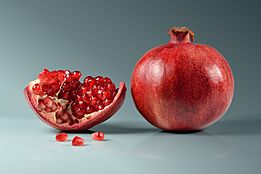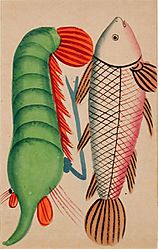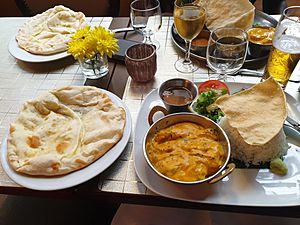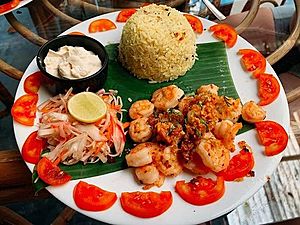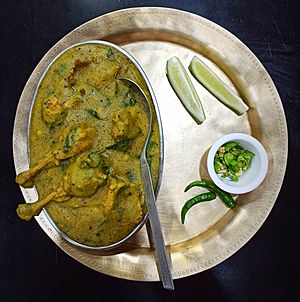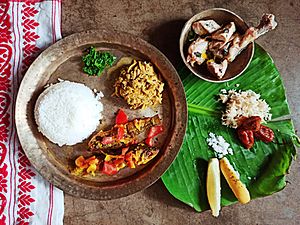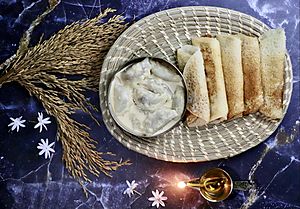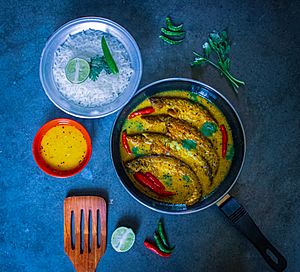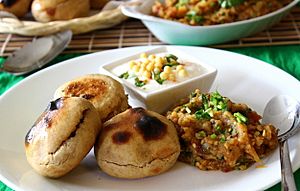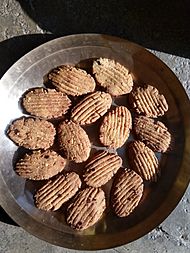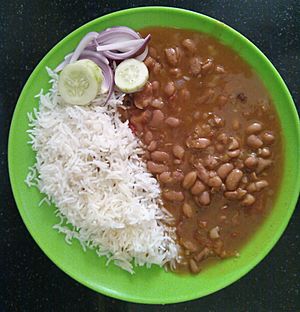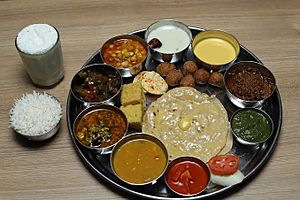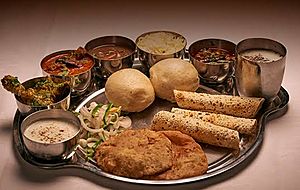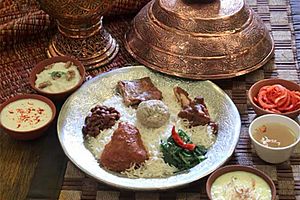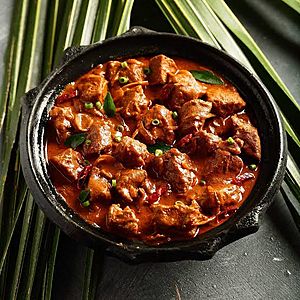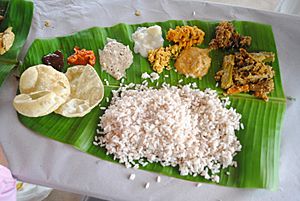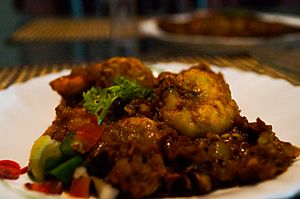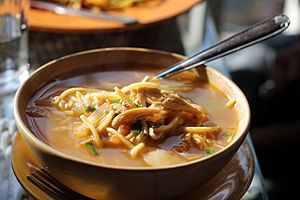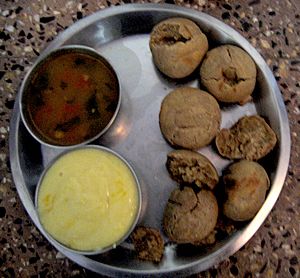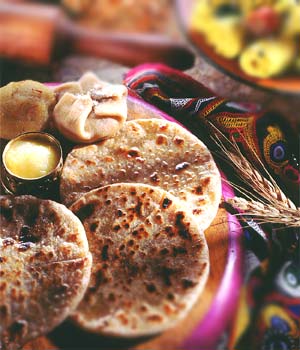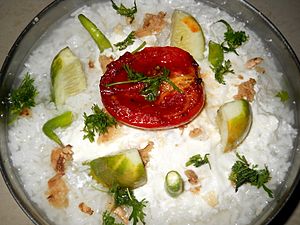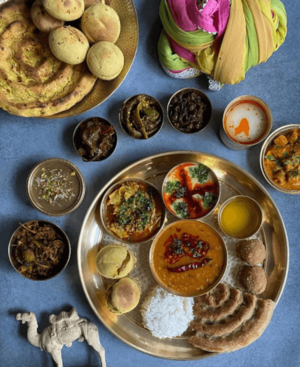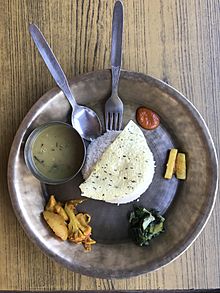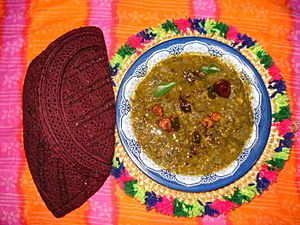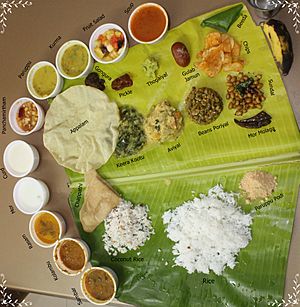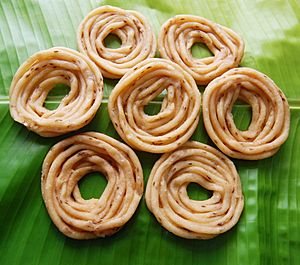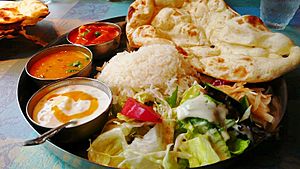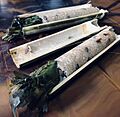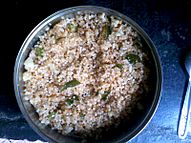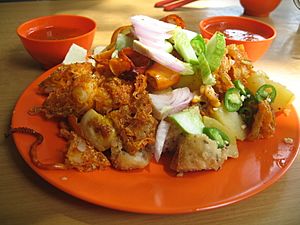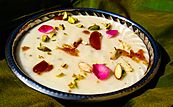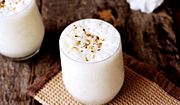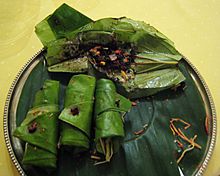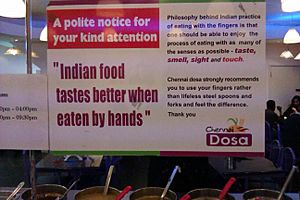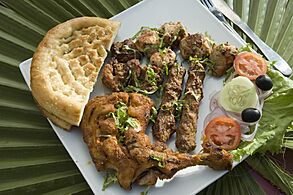Indian cuisine facts for kids
Indian cuisine is a huge mix of different foods from all over India. Because India has so many different types of land, weather, cultures, and people, its food changes a lot from one place to another. People use local spices, herbs, vegetables, and fruits in their cooking.
Indian food is also greatly shaped by religion, especially Hinduism and Islam. Cultural choices and old traditions play a big part too.
Things that happened in history, like invasions, trade, and colonialism, brought new foods to India. When the New World (the Americas) was discovered, many new vegetables and fruits came to India. Foods like potatoes, tomatoes, chillies, peanuts, and guava are now common in many parts of India.
Indian food has even changed world history! The spice trade between India and Europe was a main reason for Europe's Age of Discovery. Spices from India were traded all over Europe and Asia. Indian cuisine has also influenced food in many other parts of the world. This includes places like Europe (especially Britain), the Middle East, Southern Africa, East Africa, Southeast Asia, North America, Mauritius, Fiji, Oceania, and the Caribbean.
Contents
- A Look at Indian Food History
- Main Ingredients in Indian Cooking
- Food from Different Regions
- Andaman and Nicobar Islands
- Andhra Pradesh
- Arunachal Pradesh
- Assam
- Bengal
- Bihar
- Chandigarh
- Chhattisgarh
- Dadra and Nagar Haveli
- Daman and Diu
- Delhi
- Goa
- Gujarat
- Haryana
- Himachal Pradesh
- Jammu and Kashmir
- Jharkhand
- Karnataka
- Kerala
- Ladakh
- Lakshadweep
- Madhya Pradesh
- Maharashtra
- Manipur
- Meghalaya
- Mizoram
- Nagaland
- Odisha
- Puducherry
- Punjab
- Rajasthan
- Sikkim
- Sindh
- Tamil Nadu
- Telangana
- Tripura
- Uttar Pradesh
- Uttarakhand
- Images for kids
- Hindu Fasting Foods
- Indian Food Around the World
- Desserts
- Drinks
- Eating Habits
- Food Rules and Traditions
- Eating Manners
- Indian Food Outside India
- See also
A Look at Indian Food History
Indian food shows an 8,000-year history of different groups and cultures mixing together. This led to the many different tastes and regional foods we find in India today. Later, trade with the British and Portuguese also added to India's already diverse food.
Ancient Times: Early Farmers and Spices
Around 9000 BCE, farming ideas started to spread from the Middle East to the Indus Valley. By 7000 BCE, people in the Indus Valley began growing wheat and barley. They also started raising humped cattle.
By 3000 BCE, people in India were already harvesting turmeric, cardamom, black pepper, and mustard. These spices were very important!
Ancient records show that goods like timber and jewels were traded from the Indus Valley to places like Mesopotamia. Even Cloves, which came from the Moluccas far away, were found in ancient Indian sites.
Food in the Vedic Age
The ancient Hindu book Mahabharata talks about rice and vegetables cooked together. The word "pulao" (or "pallao") was used for this dish in old Sanskrit writings.
Ayurveda, an ancient Indian system for health, also talks about food. It focuses on how food, meditation, and yoga all work together for your well-being.
What People Ate Long Ago
Early diets in India mostly included legumes (like beans and lentils), vegetables, fruits, grains, dairy products, and honey. Today, common foods still include many types of lentils (called dal), whole-wheat flour (aṭṭa), rice, and pearl millet (bājra). Pearl millet has been grown in India since 6200 BCE.
Over time, some people started eating only vegetarian food. This happened during the Śramaṇa movement. India's good climate also allowed many different fruits, vegetables, and grains to grow all year.
In Yoga traditions, foods were put into groups: saatvic, raajsic, or taamsic. The Bhagavad Gita also gives rules about what to eat.
Eating beef is considered forbidden by many Hindus because cows are seen as sacred. Most Hindus in India do not eat beef, except in places like Kerala, parts of southern Tamil Nadu, and the northeast.
Foods from Ancient Indian Writings
Many old Indian recipes are lost, but we can learn about ancient foods from old texts. Here are a few:
- Barley: Called Yava in old Indian languages, it's mentioned many times as a main grain.
- Betel leaf: Used to wrap areca nut or tobacco for chewing, adding flavor. Sometimes used in cooking.
- Chickpeas: Used to make popular dishes like mirchi bajji.
- Curd: A traditional yogurt made from cow, buffalo, or goat milk.
- Ghee: A type of clarified butter from ancient India, used in cooking and religious rituals.
- Honey: Used for health and spiritual reasons in ancient India, mentioned in the Vedas and Ayurveda.
- Mango: A very important fruit. The Jain goddess Ambika is often shown sitting under a mango tree.
- Mustard: Grown in the Indus Valley civilization and still a key spice today.
- Pomegranate: In some Hindu traditions, it means good luck and fertility.
- Rice: Grown in India since 5,000 BC.
- Saffron: Most saffron grows in a belt from Spain to Kashmir.
- Salt: Important in Hindu and Jain religious ceremonies.
- Sesame oil: Popular in Asia, especially in South India.
- Sugar and Sugarcane: Crystalline sugar was first made in northern India.
- Turmeric: Used widely as a spice in Indian cooking.
Middle Ages to the 16th Century: New Ways and Flavors
During the Middle Ages, new cooking methods and foods like tea came to India.
Later, invaders from Central Asia brought new cooking styles, leading to Mughlai cuisine. This food mixes Indian and Central Asian flavors, often using spices like saffron.
Colonial Period: World Flavors Arrive
The Portuguese and British introduced new cooking methods like baking. They also brought foods from the New World (Americas) and Europe.
New World vegetables like tomato, potato, sweet potatoes, peanuts, squash, and chillies became very popular. Many of these, like potatoes and sweet potatoes, are even allowed on Hindu fasting days. Cauliflower, for example, was brought by the British in 1822.
-
A page from the Nimatnama-i-Nasiruddin-Shahi, a book of recipes. It shows how to make kheer.
-
An old Indian book (circa 16th century) showing samosas being served.
Main Ingredients in Indian Cooking
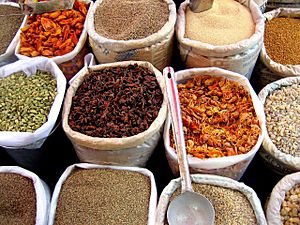
Common foods in Indian cooking include pearl millet (bājra), rice, whole-wheat flour (aṭṭa), and many kinds of lentils. These include masoor (red lentils), tuer (pigeon peas), urad (black gram), and moong (mung beans). Lentils are used whole, split, or without their husks. Split lentils, called dal, are used a lot.
Some other beans, like channa (chickpeas), rajma (kidney beans), and lobiya (black-eyed peas), are very common, especially in northern India. Chickpeas and mung beans are also made into flour (besan).
Many Indian dishes are cooked in vegetable oil. Peanut oil is popular in northern and western India, mustard oil in eastern India, and coconut oil along the western coast, especially in Kerala. Gingelly (sesame) oil is common in the south because it adds a nice nutty smell.
Recently, sunflower, safflower, cottonseed, and soybean oils have become popular all over India. A hardened vegetable oil called Vanaspati ghee is also used for cooking. But deshi ghee, which is butter-based, is still very common.
Many types of meat are used in Indian cooking. Chicken and mutton (goat or lamb meat) are eaten the most. Fish and beef are eaten in some parts of India, especially coastal areas and the northeast, but not everywhere.

The most important and common spices in Indian food are whole or powdered chilli pepper (mirch), black mustard seed (sarso), cardamom (elaichi), cumin (jeera), turmeric (haldi), asafoetida (hing), ginger (adrak), coriander (dhania), and garlic (lasoon). Chillies were brought to India by the Portuguese from Mexico in the 16th century.
A popular spice mix is garam masala. This powder usually has seven dried spices mixed in a special way. These include black cardamom, cinnamon (dalchini), clove (laung), cumin (jeera), black peppercorns, coriander seeds, and anise star. Each region and even each cook might have their own special garam masala mix. Goda masala is a similar, but sweet, spice mix popular in Maharashtra.
Some leaves commonly used for flavor are bay leaves (tejpat), coriander leaves, fenugreek (methi) leaves, and mint leaves. Using curry leaves and roots for flavor is common in Gujarati and South Indian cuisine. Sweet dishes often have cardamom, saffron, nutmeg, and rose petal flavors.
Food from Different Regions
Food changes across India's many regions. This is because of local culture, where the place is (near the sea, desert, or mountains), and how people live. Food also changes with the seasons, depending on which fruits and vegetables are ready to eat.
Andaman and Nicobar Islands
Seafood is very important in the food of the Andaman and Nicobar Islands. The native people traditionally ate roots, honey, fruits, meat, and fish that they hunted or gathered. Some insects were also eaten as special treats. Now, with people moving from mainland India, the food has more variety.
Andhra Pradesh
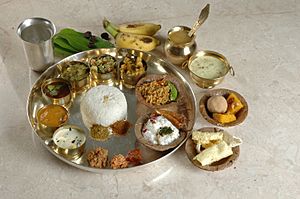
The food of Andhra Pradesh is known for using a lot of spices and tamarind. Seafood is common in the coastal areas. Rice is the main food, eaten with lentil dishes like pappu (lentils) and pulusu (stew), and spicy vegetables or curries.
In Andhra, leafy greens or vegetables like bottle-gourd and eggplant are often added to dal. Pickles are a key part of the food. Popular ones include mango pickles like avakaya, gongura (made from sorrel leaves), and tomato pickle.
Perugu (yogurt) is often eaten with meals to help cool down the spiciness. Breakfast foods include dosa, pesarattu (mung bean dosa), vada, and idli.
Arunachal Pradesh
The main food in Arunachal Pradesh is rice, along with fish, meat, and leaf vegetables. The local tribes eat meat and use fish, eggs, beef, chicken, pork, and mutton in their dishes.
Many kinds of rice are used. Boiled rice cakes wrapped in leaves are a popular snack. Thukpa is a noodle soup common among the Monpa tribe.
Lettuce is the most common vegetable, usually boiled with ginger, coriander, and green chillies.
Apong or rice beer made from fermented rice or millet is a popular drink in Arunachal Pradesh.
Assam
Assamese food mixes different local styles. It uses few spices but has strong flavors from local herbs, fruits, and vegetables. These are served fresh, dried, or fermented.
Rice is the main food, and many types of local rice, including sticky rice, are eaten. Fish, usually from freshwater, is widely eaten. Other non-vegetarian foods include chicken, duck, and pork.
Cooking is simple, mostly barbecuing, steaming, or boiling. Unlike other Indian cooking, spices are not usually fried gently before adding other ingredients.
A traditional Assamese meal starts with a khar (a dish named after its main ingredient) and ends with a tenga (a sour dish). Homemade rice beer is served before a meal. Food is usually served in bell metal dishes. Chewing betel nut (Paan) often finishes a meal.
Bengal
Mughal cooking greatly influenced Bengali food, bringing Persian and Islamic foods. It also introduced fancy ways of preparing food, like marinating with ghee. Fish, meat, rice, milk, and sugar are all very important in Bengali food.
Bengali food has four types of dishes: charbya (chewed food like rice or fish), choṣya (sucked food), lehya (licked food like chutney), and peya (drinks, mainly milk).
Bengali food is the only traditional Indian food that serves dishes one after another, like French cuisine.
Bengali food changes by region. For example, in Bangladesh's Chittagong district, they use a lot of chilli pepper. But everywhere, they use mustard oil and many spices.
The food is known for its gentle flavors, with a focus on fish, meat, vegetables, lentils, and rice. Bread, especially deep-fried luchi, is also common. Bengalis cook fish in many ways, like steaming, braising, or stewing in coconut milk or mustard sauces.
East Bengali food, found in West Bengal and Bangladesh, is much spicier than West Bengali food. It uses a lot of chilli and is one of the spiciest foods in India and the world.
Shondesh and Rashogolla are popular sweets made from sweetened, finely ground fresh cheese. Both West Bengal and Odisha claim to have invented rasgulla.
This food is also found in Tripura and the Barak Valley of Assam.
Bihar
Bihari food includes litti chokha, a baked wheat-flour cake filled with sattu (baked chickpea flour) and spices. It's served with baigan bharta, made from roasted eggplant and tomatoes.
Among meat dishes, meat saalan is popular. It's a mutton or goat curry with cubed potatoes.
Dalpuri is another popular dish: salted wheat-flour bread filled with boiled, crushed, and fried gram pulses.
Malpua is a popular sweet dish, made from flour, milk, bananas, nuts, and sugar. Another sweet is balushahi, and khaja is a famous sweet used in weddings. Silao is known for making khaja.
During the Chhath festival, thekua, a sweet made of ghee, jaggery, and flour, is prepared.
Other popular foods in Bihar are Pittha, Aaloo Bhujiya, Reshmi Kebab, Palwal ki mithai, and Puri Sabzi.
Chandigarh
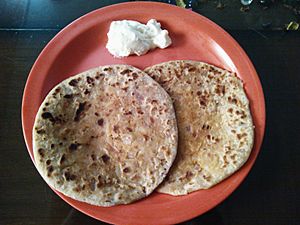
Chandigarh, the capital of Punjab and Haryana, is a modern city with a mix of food cultures, mainly North Indian. People enjoy homemade recipes like paratha, especially for breakfast. Other Punjabi foods include roti made from wheat or sweetcorn, served with cooked vegetables or beans. Sarson da saag and dal makhani are well-known dishes. Popular snacks include gol gappa (also called panipuri). It's a round, hollow puri filled with flavored water, potatoes, and beans.
Chhattisgarh
Chhattisgarh food is special and different from the rest of India, though rice is the main food. Many people drink liquor made from the mahuwa flower or palm wine. Chhattisgarhi food changes for special events and festivals. Tribal people in the Bastar region eat old dishes like mushrooms and bamboo pickle.
Dadra and Nagar Haveli
The local food here is similar to Gujarati food. Ubadiyu is a local special dish made of vegetables and beans with herbs. Common foods include rice, roti, vegetables, river fish, and crab. People also enjoy buttermilk and chutney made from different fruits and herbs.
Daman and Diu
Daman and Diu was once a Portuguese colony, like Goa. So, both local Gujarati food and traditional Portuguese food are common. Since it's a coastal area, people mainly eat seafood. For breakfast, they usually have rotli and tea. For lunch, rotla and saak. For dinner, chokha with saak and curry. On festive days, they prepare dishes like puri, lapsee, and potaya.
Delhi
Delhi was once the capital of the Mughal empire, and it's where Mughlai cuisine began. Delhi is famous for its street food. The Paranthewali Gali in Chandani Chowk is known for its stuffed flatbreads (parathas).
Delhi has people from all over India, so its food is influenced by many cultures. Punjabi food is very common.
Delhi's food is a mix of different Indian foods, changed in special ways. This is clear in the street food. Kababs, kachauri, chaat, Indian sweets, Indian ice cream (kulfi), and even Western foods like sandwiches are made in a style unique to Delhi and are very popular.
Goa
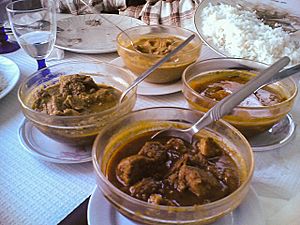
Goa has a tropical climate, so its spices and flavors are strong. Using kokum is a special part of Goan food.
Goan food is mostly seafood and meat-based. Rice and fish are the main foods. Kingfish is the most common special dish. Other fish like pomfret and mackerel are also eaten, often with coconut milk. Shellfish like crabs, prawns, and mussels are commonly eaten.
Goan food is influenced by its Hindu beginnings, 400 years of Portuguese rule, and modern cooking.
Bread, brought by the Portuguese, is very popular and an important part of Goan breakfast, often as toast.
Because of tourism, vegetarian food has also become quite popular.
Gujarat
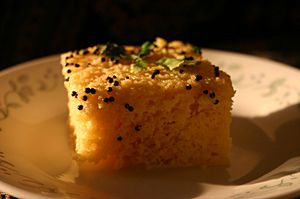
Gujarati food is mainly vegetarian. A typical Gujarati thali (a plate with many dishes) has roti, daal or kadhi, rice, sabzi (vegetables), papad, and chaas (buttermilk).
Sabzi is a dish of different vegetables and spices, which can be stir-fried, spicy, or sweet. Gujarati food can taste very different depending on personal and regional preferences. North Gujarat, Kathiawad, Kachchh, and South Gujarat are the four main regions for Gujarati food.
Many Gujarati dishes are sweet, salty, and spicy all at once. During mango season, keri no ras (fresh mango pulp) is often a part of the meal. Spices also change with the seasons. For example, garam masala is used much less in summer.
Gujarati snacks include sev khamani, khakhra, dal vada, methi na bhajiya, khaman, and bhakharwadi.
People often fast, eating only milk, dried fruit, and nuts.
Haryana
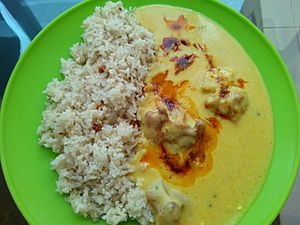
Since there are many cattle in Haryana, dairy products are a common part of its food.
Special local dishes include kadhi, pakora, besan masala roti, bajra aloo roti, churma, kheer, and tomato chutney.
In the past, their main diet included bajra khichdi, rabdi, and bajra ki roti. Non-vegetarian food includes kukad kadhai and chicken tikka masala.
Lassi, sharbat, and nimbu pani are popular non-alcoholic drinks.
Himachal Pradesh
The daily food of people in Himachal Pradesh is similar to the rest of North India. It includes lentils, broth, rice, vegetables, and bread. However, non-vegetarian food is preferred. Some special dishes from Himachal include sidu, patande, chukh, rajmah, and til chutney.
Jammu and Kashmir
The food of Jammu and Kashmir comes from two regions: Jammu and Kashmir Valley. Kashmiri food has changed over hundreds of years. It was first influenced by the food of Kashmiri Hindus and Buddhists.
Later, cultures that came with the invasion of Kashmir by Timur influenced the food. This included food from Central Asia and North India.
The most important ingredient in Kashmiri food is mutton. There are over 30 known varieties of mutton dishes. Wazwan is a multi-course meal in Kashmiri tradition, and preparing it is considered an art.
Kashmiri Pandit food is fancy and a key part of their identity. It often uses dahi (yogurt), oil, and spices like turmeric, red chilli, and ginger, but no onion or garlic. Birayanis are very popular and a specialty of Kashmir.
The Jammu region is famous for sund panjeeri, patisa, rajma with rice, and Kalari cheese.
Dogri food includes ambal (sour pumpkin), khatta meat, and maa da madra (black gram lentils in yogurt).
Many types of pickles are made, including mango and kasrod. Street food is also famous, with different types of chaats, especially gol gappas, chole bhature, and dahi bhalla.
Jharkhand
Main foods in Jharkhand are rice, dal, and vegetables. Famous dishes include chirka roti, pittha, malpua, dhuska, and litti chokha.
Local drinks include handia, a rice beer, and mahua daru, made from mahua tree flowers.
Karnataka
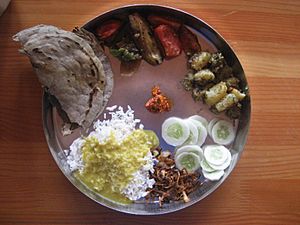
Many dishes, like idli, rava idli, and Mysore masala dosa, were created here and are now popular everywhere. Karnataka's food is similar to its three neighboring South Indian states, and also to Maharashtra and Goa. Food is often served on a banana leaf, especially during festivals.
Karnataka food can be divided into several types: Mysore/Bangalore food, North Karnataka food, Udupi cuisine, Kodagu/Coorg food, Karavali/coastal food, and Saraswat cuisine.
This food includes everything from pure vegetarian and vegan dishes to meats like pork, and from savory to sweet foods.
Typical dishes include bisi bele bath, jolada rotti, badanekai yennegai, holige, chapati, idli vada, ragi rotti, akki rotti, saaru, huli, vangibath, khara bath, kesari bhath, neer dosa, chiroti, benne dose, ragi mudde, and uppittu.
The Kodagu district is known for spicy pork curries, while coastal Karnataka specializes in seafood. Even though ingredients differ by region, a typical Kannadiga oota (Kannadiga meal) is served on a banana leaf. The coastal districts of Dakshina Kannada and Udupi use a lot of coconut in curries and often include seafood.
Kerala
Kerala food today includes both vegetarian and non-vegetarian dishes. Fish and seafood are very important because Kerala is a coastal state. A daily meal in most homes has rice with fish curry (sardines, mackerel, king fish, etc.) and vegetable curry or stir-fried vegetables with coconut, called thoran. Since Kerala has many rivers, freshwater fish are also common. It's common in Kerala to have non-vegetarian dishes for breakfast in restaurants, unlike other Indian states. Chicken or mutton stews, lamb, beef, pork, egg curry, and fish curry with tapioca are also enjoyed for breakfast.
Kerala food shows its rich trading history. Over time, different foods have mixed with local dishes, and foreign ones have been changed to suit local tastes. There are strong Arab, Syrian, Portuguese, Dutch, Jewish, and Middle Eastern influences.
Coconuts grow a lot in Kerala, so grated coconut and coconut milk are often used to make dishes thicker and more flavorful. Kerala's long coastline and many rivers mean there's a strong fishing industry, making seafood a common part of meals. Starchy foods like rice and tapioca are the main part of Kerala's diet. Since Kerala has been a major place for spice growing and trade for thousands of years, spices like black pepper, cardamom, clove, ginger, and cinnamon are used a lot.
Kerala sadhya is a big vegetarian feast prepared for festivals and ceremonies. A full sadhya, with rice and about 20 different side dishes and desserts, is a special meal. It's usually eaten for celebrations like weddings, Onam, and Vishu, and is served on a plantain leaf.
Most Hindus in Kerala, except for the Brahmin community, eat fish, chicken, beef, pork, eggs, and mutton. The Brahmins are known for their vegan food, especially different kinds of sambar and rasam. A thick vegetable stew called avial is thought to have started in southern Kerala. Avial is a very important vegetarian dish in Kerala sadhya.
Kerala also has many breakfast dishes like idli, dosa, appam, puttu, and parotta. These are served with sambar, coconut chutney, egg curry, chickpea curry, and meat curries.
The Muslim community in Kerala mixes Arabian, North Indian, and local Malabari foods, using chicken, eggs, beef, and mutton. Thalassery biryani is a unique biryani from Kerala. Snacks like Pazham nirachathu and Unnakkai are also contributions from the Muslim community.
The Pathanamthitta region is known for raalan and fish curries. Appam with wine and curries of duck, pork, and cured beef are popular among Syrian Christians in Central Kerala.
Popular desserts are payasam (pudding) and halwa. Payasam, especially Ambalappuzha Paalpayasam, is a famous sweet. Kerala has many payasam types.
Halva is a common sweet in bakeries throughout Kerala. It started with the Gujarati community in Calicut. Europeans called it "sweetmeat" because of its texture, and a street in Kozhikode was named Sweet Meat Street during colonial rule. It's mostly made from maida (refined wheat flour) and comes in flavors like banana or coconut. Black haluva made from rice is also very popular.
Ladakh
Ladakhi food is from the districts of Leh and Kargil in Ladakh. Ladakhi food is very similar to Tibetan food. The most common foods are thukpa (noodle soup) and tsampa, called ngampe in Ladakhi (roasted barley flour). Tsampa can be eaten without cooking, making it good for trekking.
Special Ladakhi dishes include skyu and chutagi, which are thick, rich soup pasta dishes. Skyu is made with root vegetables and meat, and chutagi with leafy greens and vegetables. As Ladakh becomes more modern, foods from other parts of India are becoming more common.
Like in other parts of Central Asia, tea in Ladakh is traditionally made with strong green tea, butter, and salt. It's mixed in a large churn and called gurgur cha. Sweet tea (cha ngarmo) is now common, made like Indian tea with milk and sugar. Most of the extra barley is fermented into chang, an alcoholic drink for special occasions.
Lakshadweep
The food of Lakshadweep mainly features seafood and coconut. Local food includes spicy non-vegetarian and vegetarian dishes.
The influence of Kerala's food is clear in Lakshadweep, as the island is close to Kerala. Coconut and sea fish are the base of most meals.
People in Lakshadweep drink a lot of coconut water. Coconut milk is used for most curries. All sweet or savory dishes have a touch of famous Malabar spices. Local people also like dosa, idlis, and various rice dishes.
Madhya Pradesh
The food in Madhya Pradesh varies by region. Wheat and meat are common in the north and west, while rice and fish are common in the wetter south and east. Milk is a common ingredient in Gwalior and Indore.
The street food of Indore is well known, with shops that have been there for generations. Bhopal is known for meat and fish dishes like rogan josh, korma, qeema, biryani, and kebabs. On a street called Chatori Gali in old Bhopal, you can find traditional Muslim non-vegetarian food like paya soup and bun kabab.
Dal bafla is a common meal. It's a steamed and grilled wheat cake dipped in rich ghee, eaten with daal and ladoos.
A special food from the Malwa and Indore regions is poha (flattened rice), usually eaten for breakfast with jalebi.
Drinks include lassi, beer, rum, and sugarcane juice. A local drink is made from the flowers of the mahua tree. Date palm toddy is also popular. In tribal areas, a popular drink is the sap of the sulfi tree, which can be alcoholic.
Maharashtra
Maharashtrian food has a good balance of many different tastes, from mild to very spicy. Bajri, wheat, rice, jowar, vegetables, lentils, and fruit are important parts of the Maharashtrian diet.
Popular dishes include puran poli, ukdiche modak, batata wada, sabudana khichdi, masala bhat, pav bhaji, and wada pav. Poha (flattened rice) is also usually eaten for breakfast. Kanda poha and aloo poha are cooked for breakfast and evening snacks.
Popular spicy meat dishes include those from the Kolhapur region, like Kolhapuri Sukka mutton. Shrikhand, a sweet dish made from strained yogurt, is a main dessert.
Maharashtrian food can be divided into two main parts: coastal and interior. The Konkan coast has its own food, a mix of Malvani, Goud Saraswat Brahmin, and Goan cuisine. In the interior, areas like Paschim Maharashtra and Vidarbha have their own distinct foods.
The food of Vidarbha uses groundnuts, poppy seeds, jaggery, wheat, jowar, and bajra a lot. A typical meal has rice, roti, or bhakar, with varan and aamtee (lentils and spiced vegetables).
Savji food from Vidarbha is known all over Maharashtra. Savji dishes are very spicy and oily. Savji mutton curries are very famous.
Like other coastal states, there are many vegetables, fish, and coconuts, which are common ingredients. Peanuts and cashews are often served with vegetables. Grated coconuts are used to flavor many dishes, but peanut oil is preferred over coconut oil.
Kokum, often served chilled in a drink called sol kadhi, is common. In summer, Maharashtrians drink panha, made from raw mango.
Malwani Food
Malwani food is special to the tropical area from Deogad Malwan to the southern Maharashtra border with Goa. Its unique taste comes from Malwani masala and the use of coconut and kokam.
The main foods are rice and fish. Many kinds of red and green fish, prawns, crab, and shellfish curries are well known, along with kombadi (chicken) wade and mutton cooked Malwani style.
Many types of fish are available, like surmai, bangada, bombil (Bombay duck), and paplet (pomfret). These fish are also available dried. Local curries and chatanis are made with dried fish.
Different types of rice breads and pancakes add to the variety, including tandlachi bhakari, ghawane, and amboli. These rice breads can be eaten with coconut milk, fish curries, and chicken or mutton curries.
Sole kadi, made from kokam and coconut milk, is a special appetizer drink. For vegetarians, Malwani special dishes include alloochi bhaji and kalaya watanyacha.
Sweets and desserts include ukadiche modak, Malawani khaje, and tandalchi kheer.
Manipur
Manipuri food is mostly from the Meitei people. Meitei food is simple, tasty, organic, and healthy. Rice with local seasonal vegetables and fish are the main diet.
Most dishes are cooked like vegetable stew, flavored with either fermented fish called ngari, or dried and smoked fish.
The most popular Manipuri dish is eromba, made of boiled and mashed vegetables, often with carrots or potatoes, mixed with chilli and roasted fermented fish.
Another popular dish is paknam, a savory cake made of lentil flour stuffed with things like banana flowers or mushrooms, and baked in turmeric leaves.
Along with spicy dishes, a mild side dish of steamed or boiled sweet vegetables is often served. The Manipuri salad called singju, made of finely cut cabbage, green papaya, and other vegetables, is very popular. It's often sold by street vendors.
Singju is often served with bora (fritters) and kanghou (oil-fried spicy veggies). Cooked and fermented soybean is a popular seasoning in Manipuri kitchens.
The main diet in Manipur is rice, fish, and many kinds of leafy vegetables. People often grow vegetables in their kitchen gardens and raise fish in small ponds. So, the food is very seasonal, with special vegetables and dishes for each season.
The taste is very different from mainland Indian food because of the many aromatic herbs and roots unique to the region. They are similar to foods from Southeast, East, and Central Asia.
Meghalaya

Meghalayan food is unique. Spiced meat is common, from goats, pigs, chickens, and cows. In the Khasi and Jaintia Hills districts, common foods include jadoh, ki kpu, tung-rymbai, and pickled bamboo shoots.
Other common foods in Meghalaya include minil songa (steamed sticky rice), sakkin gata, and momo dumplings.
Like other tribes in the northeast, the Garos ferment rice beer, which they drink in religious ceremonies and celebrations.
Mizoram
The food of Mizoram is different from most of India, but shares traits with other parts of Northeast India.
Rice is the main food. Mizos love to add non-vegetarian ingredients to every dish. Fish, chicken, pork, and beef are popular meats. Dishes are served on fresh banana leaves. Most dishes are cooked in mustard oil.
Meals tend to be less spicy than in most of India. Mizos love eating boiled vegetables with rice. A popular dish is bai, made from boiling vegetables with bekang (fermented soya beans) or sa-um (fermented pork fat), served with rice. Sawhchiar is another common dish, made of rice cooked with pork or chicken.
Nagaland
The food of Nagaland reflects the Naga people. It's known for special pork meats cooked with simple, flavorful ingredients. These include the very hot bhut jolokia (ghost chili) pepper, fermented bamboo shoots, and akhuni (fermented soya beans). Another unique and strong ingredient is fermented fish called ngari.
Fresh herbs and local greens are also important. The Naga use oil sparingly, preferring to ferment, dry, and smoke their meats and fish.
Traditional homes in Nagaland have outside kitchens that act as smokehouses.
A typical meal has rice, meat, a chutney, and a couple of stewed or steamed vegetable dishes, flavored with ngari or akhuni. Desserts are usually fresh fruits.
Odisha
The food of Odisha uses a lot of local ingredients. Flavors are usually mild and gently spiced. Fish and other seafood, like crab and shrimp, are very popular. Chicken and mutton are also eaten.
Panch phutana, a mix of five spices (cumin, mustard, fennel, fenugreek, and kalonji), is widely used for flavoring vegetables and dals. Garam masala and turmeric are common for meat curries.
Pakhala, a dish of rice, water, and dahi (yogurt) that ferments overnight, is very popular in summer in rural areas. Oriyas love sweets, so dessert usually follows most meals.
Popular Oriya dishes include anna, kanika, dalma, khata (tomato and oou), dali (different lentils), spinach, and alu-bharta (mashed potato) with pakhala.
Odisha and West Bengal both claim to have invented rasgulla. Odisha is also known for its chhena-based sweets, like chhena poda and chhena gaja.
Puducherry
The union territory of Puducherry was a French colony for about 200 years. This means French cuisine strongly influenced the area. Tamil cuisine is eaten by the majority Tamil population. Food from nearby Andhra Pradesh and Kerala also influences the cuisine here.
Some favorite dishes include coconut curry, tandoori potato, soya dosa, podanlangkai (snake gourd chutney), curried vegetables, stuffed cabbage, and baked beans.
Punjab
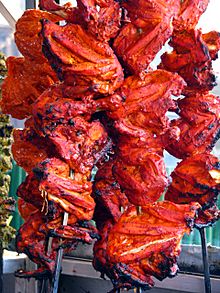
The food of Punjab is known for its wide range of dishes. It's very similar to the food of the Punjab province in Pakistan.
Since Punjab is an agriculture center, it has plenty of whole grains, vegetables, and fruits. Punjabi food cooked at home can be very different from restaurant food.
Restaurant Punjabi cooking uses a lot of ghee, butter, and cream for creamy textures. Home-cooked meals focus on whole wheat, rice, and other ingredients flavored with different masalas.
Common homemade dishes are roti with daal and dahi (yogurt), with a side of chutney and salad (raw onion, tomato, cucumber).
Meals also have many local and seasonal vegetables, usually cooked with spices like cumin, dried coriander, red chili powder, and turmeric. Masala chai is a favorite drink, enjoyed daily and on special occasions.
There are many regional differences in Punjabi food based on how dishes are cooked, food combinations, and spice preferences. The food is "simple, strong, and closely linked to the land."
Special dishes unique to Punjab include makki di roti and sarson da saag, dal makhani, and others.
The masala in a Punjabi dish traditionally has onion, garlic, ginger, cumin, garam masala, salt, turmeric, and tomatoes cooked in mustard oil. Tandoori food is a Punjabi specialty. Dishes like Bhatti da murgh (tandoori chicken), Chicken hariyali kabab, and Amritsari kulcha are popular tandoori foods from Punjab.
Common meat dishes are Bhakra curry (goat) and fish dishes. Dairy products are enjoyed regularly, like dahi, milk, and products like lassi and paneer.
Many Sikh people in Punjab traditionally eat a vegetarian diet (plant-based foods, milk, and milk products) according to their beliefs.
Punjabi food also has many famous desserts, like kheer, gajar ka halwa, sooji (cream of wheat) halwa, rasmalai, gulab jamun, and jalebi. Most desserts use ghee or dairy, nuts, and raisins.
Many popular parts of Anglo-Indian cuisine, like tandoori foods, naan, pakoras, and vegetable dishes with paneer, come from Punjabi styles.
Punjabi food is well-liked worldwide for its flavors and spices. Chole bhature and chhole kulche are famous all over North India.
Rajasthan
Cooking in Rajasthan, a dry region, has been greatly shaped by what ingredients are available. Food is generally cooked in milk or ghee, making it very rich. Gram flour is a main ingredient in Marwar food because vegetables are scarce.
Historically, people preferred food that could last for several days and be eaten without heating. Main dishes include daal-baati, tarfini, raabdi, ghevar, bail-gatte, panchkoota, chaavadi, laapsi, kadhi, and boondi. Typical snacks include bikaneri bhujia, mirchi bada, and pyaaj kachori.
Daal-baati is the most popular dish. It's usually eaten with choorma, a mix of finely ground baked rotis, sugar, and ghee.
Rajasthan is also influenced by the Rajput community, who like meat dishes. Their diet included game meat and led to dishes like laal maans and jungli maas.
Sikkim
In Sikkim, different groups like the Nepalese, Bhutias, and Lepchas have their own special foods. Nepalese cuisine is very popular here.
Rice is the main food, and meat and dairy products are also eaten a lot. For centuries, traditional fermented foods and drinks have made up about 20 percent of the local diet.
Depending on how high up the land is, people grow finger millet, wheat, buckwheat, barley, vegetables, potatoes, and soybeans. Dhindo, daal bhat, gundruk, momo, gya thuk, ningro, phagshapa, and sel roti are some local dishes.
Beef is eaten by Bhutias.
Sindh
Sindhi food comes from the Sindhi people of the Sindh region, which is now in Pakistan. Even though Sindh is not part of modern India, its food traditions continue. This is because many Hindu Sindhis moved to India after Pakistan became independent in 1947, especially in places like Ulhasnagar.
A typical meal in many Sindhi homes includes wheat-based flatbread (phulka) and rice with two dishes: one with gravy and one dry. Lotus stem (kamal kakri) is also used. Deep frying vegetables is common.
Some regular Sindhi dishes are sindhi kadhi, sai bhaji, koki, and besan bhaji. Common ingredients are mango powder, tamarind, kokum flowers, and dried pomegranate seeds.
Tamil Nadu
Tamil Nadu is known for its strong belief that serving food to others is a service to humanity. The region has rich food with both traditional non-vegetarian and vegetarian dishes.
Tamil food uses rice, beans, and lentils. It has special smells and flavors from spices like mustard, curry leaves, tamarind, coriander, ginger, garlic, chili pepper, cinnamon, clove, cardamom, cumin, nutmeg, coconut, and rose water.
Traditionally, people sit on the floor, eat food served on a plantain leaf, and use their right hand. After the meal, the leaf is thrown away and becomes food for cattle and goats.
A meal (called saapadu) has rice with other typical Tamil dishes on a plantain leaf. Eating on a plantain leaf is believed to give a different flavor to the food. Stainless-steel trays with small bowls for different dishes are also popular now.
Tamil food is known for tiffin, which is a light meal for breakfast or dinner. Lunch is usually a bigger meal. The word "curry" comes from the Tamil word kari, meaning "sauce."
Southern regions like Tirunelveli, Madurai, and Chettinad are known for their spicy non-vegetarian dishes. Dosa, idli, pongal, and biryani are popular dishes eaten with chutney and sambar. Fish and other seafood are also very popular because the state is on the coast. Chicken and goat meat are the main meats eaten.
A typical Tamil vegetarian meal relies heavily on rice, vegetables, and lentil dishes like rasam and sambar. The Chettinad food uses many strong spices like pepper, garlic, and fennel seeds. Tamil food tends to be spicy, so people often finish the meal with dahi (yogurt) to cool down.
Tamil Brahmin food, from the Iyers and Iyengar community, has slightly different meal times and structures. Historically vegetarian, this food is known for its milder flavor and avoids onion and garlic (though this is changing).
After a light morning meal of filter coffee and porridges, the main meal (lunch/brunch) is usually at 11 am. It typically has two or three courses. Steamed rice is the main dish, always with a seasonal vegetable dish (poriyal) and two or three types of tamarind stews, like sambhar and rasam. The meal usually ends with thair sadham (rice with yogurt).
Tiffin is the second meal, featuring breakfast favorites like idli, dosa, and vada, usually with chai.
Dinner is the simplest meal, often using leftovers. Fresh seasonal fruits include bananas, papaya, mangoes, and pomegranates.
Telangana
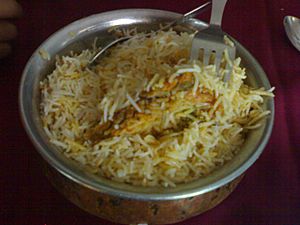
The food of Telangana includes Telugu cuisine (from the Telugu people) and Hyderabadi cuisine (from the Hyderabadi Muslim community).
Hyderabadi food uses a lot of non-vegetarian ingredients. Telugu food mixes both vegetarian and non-vegetarian ingredients. Telugu food is rich in spices and uses a lot of chillies. It also tends to be tangy, using tamarind and lime juice a lot.
Rice is the main food for Telugu people. It's eaten with various curries and lentil soups. Both vegetarian and non-vegetarian foods are popular.
Hyderabadi food includes popular dishes like biryani, haleem, Baghara baingan, and kheema. Daily Hyderabadi dishes are similar to Telanganite Telugu food, using tamarind, rice, and lentils, along with meat. Dahi (yogurt) is often added to meals to balance the spiciness.
Tripura

The Tripuri people are the original people of Tripura in northeast India. They are non-vegetarian, though a small number are vegetarian.
The main ingredients in Tripuri food include vegetables, herbs, pork, chicken, mutton, fishes, turtle, shrimps, crabs, and freshwater mussels.
Uttar Pradesh
Traditionally, Uttar Pradeshi food includes Awadhi, Bhojpuri, and Mughlai cuisine. However, most people in the state are vegetarian, preferring dal, roti, sabzi, and rice. Pooris and kachoris are eaten on special occasions.
Chaat, samosa, and pakora, which are among the most popular snacks in India, come from Uttar Pradesh.
Well-known dishes include kebabs, dum biryani, and various mutton recipes. Sheer qorma, ghevar, gulab jamun, kheer, and ras malai are popular desserts.
Awadhi cuisine is from Lucknow, the capital of Uttar Pradesh. Its cooking styles are similar to those of Central Asia and the Middle East. This food includes both vegetarian and non-vegetarian dishes.
Awadh was greatly influenced by Mughal cooking. Lucknow's food is similar to that of Kashmir, Punjab, and Hyderabad. The city is also known for its Nawabi foods. The cooks of Awadh created the dum style of cooking (cooking over a slow fire), which is now famous in Lucknow. Their meals included fancy dishes like kebabs, kormas, biryani, kaliya, and zarda.
The richness of Awadh food comes from the variety of dishes and ingredients like mutton, paneer, and rich spices like cardamom and saffron.
Mughlai cuisine was developed in the Indian subcontinent by the kitchens of the Mughal Empire. It represents cooking styles used in North India (especially Uttar Pradesh).
This food is strongly influenced by Central Asian cuisine. It has also greatly influenced the foods of Kashmir and the Punjab region.
The tastes of Mughlai food range from very mild to spicy. It often has a special aroma and the taste of ground and whole spices. A Mughlai meal is a big spread of main dishes with many side dishes.
Uttarakhand
Food from Uttarakhand is known to be healthy and filling, perfect for the cold, mountainous region. It's a high-protein diet that uses a lot of pulses (beans and lentils) and vegetables. Traditionally, it's cooked over wood or charcoal fires, mostly using iron pots.
While using common spices like jeera, haldi, and rai, Uttarakhand food also uses special ingredients like jambu and bhangira.
Although people in Uttarakhand also make dishes common in other parts of North India, some foods are unique to Uttarakhand, such as rus, chudkani, dubuk, and jholi.
Among salads and sauces, kheere ka raita and nimbu mooli ka raita are popular.
The food mainly comes from two sub-regions: Garhwal and Kumaon. Their basic ingredients are the same. Both Kumaoni and Garhwali styles use a lot of ghee, lentils, vegetables, and bhaat (rice). They also use badi (sun-dried urad dal balls) and mungodi (sun-dried moong dal balls) sometimes instead of vegetables.
During festivals, people in Uttarakhand prepare special snacks. These include salty ones like bada and sweet ones like pua and singal. Uttarakhand also has several sweets (mithai) like singodi, bal-mithai, and malai laddu, which are traditional to the region.
Images for kids
-
Daulat Chaat in Old Delhi
-
Butter Chicken & Butter Naan
-
Locho and Idada
-
Luchi Alur Torkari
Hindu Fasting Foods
Hindu people fast on certain days, like Ekadashi (for Lord Vishnu), Chaturthi (for Ganesha), or Mondays (for Shiva).
Only certain foods are allowed on these days. These include milk and other dairy products (like dahi), fruit, and foods like sago, potatoes, purple-red sweet potatoes, amaranth seeds, nuts, and shama millet.
Popular fasting dishes include farari chevdo, sabudana khichadi, and peanut soup.
Indian Food Around the World
When Indian people moved to other countries, they brought their cooking traditions with them. These foods changed to fit local tastes and also influenced the local foods. The popularity of curry around the world is like that of pizza. Indian tandoor dishes like chicken tikka are also very popular.
Indian Chinese Food

Indian Chinese food, also called Indo-Chinese food, started in the 1800s among the Chinese community of Calcutta. They came from Canton to escape wars and problems. When they saw local Indian food, they added many spices and cooking methods to their own Hakka food. This created a special mix of Indian and Chinese food.
After 1947, many Cantonese immigrants opened restaurants in Calcutta. Their dishes mixed Indian food with Cantonese cuisine. In other parts of India, Indian Chinese food comes from Calcutta-Chinese food. But it doesn't look much like real Chinese food because it uses spices like cumin, coriander seeds, and turmeric, which are not traditional in Chinese cooking. Chilli, ginger, garlic, and dahi (yogurt) are also used a lot.
Popular dishes include Chicken Manchurian, chicken lollipop, chilli chicken, Hakka noodles, and Szechwan fried rice.
Soups like Manchow soup and sweet corn soup are very popular. Desserts include ice cream on honey-fried noodles.
Chowmein is now one of the most favorite Chinese dishes in India, especially as street food in West Bengal.
Malaysian Indian Food
Malaysian Indian food is the cooking of Indian communities in Malaysia. It includes changed versions of real Indian dishes and new dishes inspired by Malaysia's diverse food culture.
A typical Malaysian Indian dish will likely have a lot of curry leaves, whole and powdered spices, and fresh coconut in different forms.
Ghee is still used a lot for cooking, but vegetable oils and palm oils are now common in homes.
Indian Singaporean Food
Indian Singaporean food refers to foods and drinks in Singapore that come from South Asian cooking traditions.
The wide variety of Singaporean food includes Indian food, which is often Tamil cuisine, especially local Tamil Muslim food. North Indian food has also become more visible recently.
Indian dishes have changed over time due to contact with other Singaporean cultures and local ingredients.
Indian Indonesian Food
Indian-Indonesian food refers to dishes in Indonesian cuisine that have been influenced by Indian food, especially from Tamil, Punjabi, and Gujarati. These dishes are well mixed, such as appam, biryani, murtabak, and curry.
Indian Filipino Food
Filipino cuisine, found throughout the Philippines, has been influenced by Indian food in the past. Indian influences can be seen in rice-based sweets like bibingka and puto, which might come from the south Indian puttu.
The kare-kare dish might have started during the Seven Years' War. British soldiers, including Indian sepoys, occupied Manila. They had to make Indian dishes without many spices, which might explain the thick, yellow-orange sauce that looks like a type of curry.
Atchara in the Philippines came from the Indian achar.
Anglo-Indian Food
Anglo-Indian cuisine developed when the British ruled India. British officials and their Indian cooks mixed their cooking styles.
Well-known Anglo-Indian dishes include chutneys, salted beef tongue, kedgeree, and mulligatawny soup.
Desserts
Many Indian desserts, called mithai, are fried foods made with sugar, milk, or condensed milk. The ingredients and types of dessert change by region. In eastern India, most are made from milk products.
Many are flavored with almonds and pistachios, spiced with cardamom, nutmeg, and cloves. They are often decorated with nuts or silver leaf. Popular Indian desserts include rasogolla, gulab jamun, jalebi, laddu, and peda.
Drinks
Non-alcoholic Drinks
Tea is a main drink all over India, as India is one of the biggest tea producers. Popular teas include Assam tea, Darjeeling tea, and Nilgiri tea. It's made by boiling tea leaves in water, milk, and spices like cardamom and ginger. In India, tea is often enjoyed with snacks like biscuits and pakoda.
Coffee is another popular drink, especially in South India. It's also grown in some parts of India. Two types of coffee are popular: Indian filter coffee and instant coffee.
Lassi is a traditional yogurt-based drink. It's made by blending yogurt with water or milk and spices. Salted lassi is common in Punjab villages. Traditional lassi is sometimes flavored with roasted cumin. Lassi can also be flavored with sugar, rose water, mango, or saffron.
Sharbat is a sweet cold drink made from fruits or flower petals. It can be served thick or mixed with water. Popular sharbats are made from rose, sandalwood, lemon, orange, and pineapple. In Ayurveda, sharbats are believed to have medicinal benefits.
Thandai is a cold drink made with a mix of almonds, fennel seeds, rose petals, pepper, poppy seeds, cardamom, saffron, milk, and sugar. It's from India and is often linked to the Maha Shivaratri and Holi festivals.
Other drinks include nimbu pani (lemonade), chaas, badam doodh (almond milk with nuts and cardamom), Aam panna, kokum sharbat, and coconut water.
Modern fizzy cold drinks unique to South India include panner soda (carbonated water, rose water, rose milk, and sugar) and naranga soda (carbonated water, salt, and lemon juice).
-
Darjeeling tea in varieties.
-
Malai Lassi served at an Indian restaurant.
-
Indian filter coffee is popular in Southern India.
-
Badam milk.
-
Holi Special Chilled Thandai.
Eating Habits
Indians think a healthy breakfast is important. They usually drink tea or coffee with breakfast. Food choices change by region. North Indian people like roti, parathas, and a vegetable dish with achar (a pickle) and some curd. Many types of packaged pickles are sold.
People in Gujarat prefer dhokla and milk. South Indians prefer idli and dosa, usually with sambhar or sagu and different chutneys.
Traditional lunch in India usually has rice as the main dish in the south and east, and whole-wheat rotis in the north. It typically includes two or three kinds of vegetables, and sometimes kulcha, naan, or parathas. Paan (stuffed, spiced betel leaves) helps digestion and is often eaten after lunch and dinner.
Indian families often gather for "evening snack time," like tea time, to talk and have tea and snacks.
Dinner is considered the main meal of the day. Many homes, especially in north and central India, like to have sweets after dinner.
Food Rules and Traditions
In India, people often follow food rules based on their religious beliefs:
- Some Hindu communities do not eat beef because they believe Hindu scriptures forbid killing cows. Cow slaughter is banned in many Indian states. However, these rules are not followed in the North-Eastern states, West Bengal, and Kerala.
- Vaishnavism followers are usually strict lacto-vegetarians (they eat dairy but no meat, fish, or eggs) because they believe in Ahimsa (non-violence). They also do not eat garlic and onions.
- Jains follow a very strict form of lacto-vegetarianism called Jain vegetarianism. This diet also excludes all root vegetables like carrots and potatoes because when the root is pulled, tiny living things around it also die.
- Muslims do not eat pork or pork products.
- Except in some North-Eastern regions, dogs are not eaten.
Eating Manners
Traditionally, meals in India are eaten while sitting on the floor or on very low stools. Food is most often eaten with the hands, not with forks or spoons.
Often, roti is used to scoop curry without letting the curry touch the hand. In the north, a piece of roti is held with the thumb and middle finger and torn off.
A slightly different way is used in the south for dosai and uththappam. Here, the middle finger holds the bread down, and the pointer finger and thumb are used to tear off a small piece. Traditional serving styles vary across India.
Contact with other cultures has changed Indian eating manners. For example, the Anglo-Indian middle class often uses spoons and forks, like in Western culture.
In South India, clean banana leaves are used to serve food. These leaves can be thrown away after meals. When hot food is served on banana leaves, the leaves add special smells and tastes to the food. Leaf plates are less common now, except for special occasions.
Indian Food Outside India
Indian people moving around the world have spread Indian cooking traditions. These foods have changed to fit local tastes and have also influenced local foods. The worldwide popularity of curry is like that of pizza. Indian tandoor dishes like chicken tikka are also very popular.
Australia
A survey from 2013-2018 found that Indian cuisine was the top-rated international food for 51% of Australians, after Chinese, Italian, and Thai.
Canada
Like in the United Kingdom and the United States, Indian food is widely available in Canada. This is especially true in cities like Toronto, Vancouver, and Ottawa, where many Canadians of South Asian heritage live.
China
Indian food is becoming more popular in China. There are many Indian restaurants in Beijing, Shanghai, and Shenzhen. Hong Kong alone has over 50 Indian restaurants, some from the 1980s. Most Indian restaurants in Hong Kong are in Tsim Sha Tsui.
Middle East
The Indian food scene in the Middle East has been greatly influenced by the large number of Indian people living there. Hundreds of years of trade and cultural exchange led to a big influence on each region's food. The use of the tandoor, which started in northwestern India, is an example.
Many Indian people moved to Middle Eastern countries in the 1970s and 1980s. This led to many Indian restaurants opening to serve them. These restaurants were also influenced by local and international foods.
Nepal
Indian food is available on the streets of Nepalese cities, including Kathmandu and Janakpur.
Southeast Asia

Other foods that get ideas from Indian cooking styles include Cambodian, Lao, Filipino, Vietnamese, Indonesian, Thai, and Burmese foods. The spread of vegetarianism in other parts of Asia is often linked to Hindu and Buddhist practices.
Indian food is very popular in Southeast Asia because of the strong Hindu and Buddhist cultural influence there. Indian food has greatly influenced Malaysian cooking styles and is also popular in Singapore. There are many North and South Indian restaurants in Singapore, mostly in Little India.
Singapore is also known for fusion cuisine that mixes traditional Singaporean cuisine with Indian influences. Fish head curry, for example, is a local creation. Indian influence on Malay cuisine dates back to the 1800s.
United Kingdom
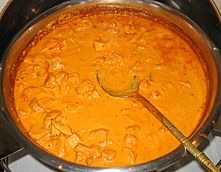
The UK's first Indian restaurant, the Hindoostane Coffee House, opened in 1810. By 2003, there were as many as 10,000 restaurants serving Indian food in England and Wales alone. According to Britain's Food Standards Agency, the Indian food industry in the UK is worth 3.2 billion pounds. It makes up two-thirds of all eating out in the country and serves about 2.5 million customers every week.
One of the best-known examples of British Indian restaurant food is chicken tikka masala, which has been called "a true British national dish."
Ireland
Ireland's first Indian restaurant opened in 1908 in Dublin. Today, Indian restaurants are common in most Irish cities and towns. Non-Chinese Asians are the fastest growing ethnic group in Ireland.
United States
A survey in 2007 said that over 1,200 Indian food products had been introduced into the United States since 2000. There are many Indian restaurants across the US, which vary based on regional culture and climate. North Indian and South Indian foods are especially well represented. Most Indian restaurants in the United States serve Americanized versions of North Indian food, which is usually less spicy than in India.
At sit-down restaurants with North Indian cuisine (the most common), free papadum is served with three dipping sauces (mint and cilantro, tamarind, and a spicy red chili or onion chutney) instead of European-style bread before the meal.
See also
 In Spanish: Gastronomía de la India para niños
In Spanish: Gastronomía de la India para niños


